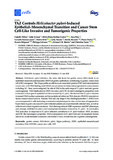Mostrar el registro sencillo del ítem
TAZ Controls Helicobacter pylori-Induced Epithelial–Mesenchymal Transition and Cancer Stem Cell-Like Invasive and Tumorigenic Properties
| dc.creator | Tiffon, Camille | |
| dc.creator | Giraud, Julie | |
| dc.creator | Molina Castro, Silvia Elena | |
| dc.creator | Peru, Sara | |
| dc.creator | Seeneevassen, Lornella | |
| dc.creator | Sifré, Elodie | |
| dc.creator | Staedel, Cathy | |
| dc.creator | Bessède, Emilie | |
| dc.creator | Dubus, Pierre | |
| dc.creator | Mégraud, Francis | |
| dc.creator | Lethours, Philippe | |
| dc.creator | Martin, Océane C.B. | |
| dc.creator | Varon, Christine | |
| dc.date.accessioned | 2021-10-22T16:13:01Z | |
| dc.date.available | 2021-10-22T16:13:01Z | |
| dc.date.issued | 2020 | |
| dc.identifier.citation | https://www.mdpi.com/2073-4409/9/6/1462 | |
| dc.identifier.issn | 2073-4409 | |
| dc.identifier.uri | https://hdl.handle.net/10669/84676 | |
| dc.description.abstract | Helicobacter pylori infection, the main risk factor for gastric cancer (GC), leads to an epithelial–mesenchymal transition (EMT) of gastric epithelium contributing to gastric cancer stem cell (CSC) emergence. The Hippo pathway e ectors yes-associated protein (YAP) and transcriptional co-activator with PDZ binding motif (TAZ) control cancer initiation and progression in many cancers including GC. Here, we investigated the role of TAZ in the early steps of H. pylori-mediated gastric carcinogenesis. TAZ implication in EMT, invasion, and CSC-related tumorigenic properties were evaluated in three gastric epithelial cell lines infected by H. pylori. We showed that H. pylori infection increased TAZ nuclear expression and transcriptional enhancer TEA domain (TEAD) transcription factors transcriptional activity. Nuclear TAZ and zinc finger E-box-binding homeobox 1 (ZEB1) were co-overexpressed in cells harboring a mesenchymal phenotype in vitro, and in areas of regenerative hyperplasia in gastric mucosa of H. pylori-infected patients and experimentally infected mice, as well as at the invasive front of gastric carcinoma. TAZsilencing reduced ZEB1 expression andEMTphenotype, and strongly inhibited invasion and tumorsphere formation induced by H. pylori. In conclusion, TAZ activation in response to H. pylori infection contributes to H. pylori-induced EMT, invasion, and CSC-like tumorigenic properties. TAZ overexpression in H. pylori-induced pre-neoplastic lesions and in GC could therefore constitute a biomarker of early transformation in gastric carcinogenesis. | es_ES |
| dc.description.sponsorship | Ligue Nationale Française Contre le Cancer (French National League against Cancer)/[]//Francia | es_ES |
| dc.description.sponsorship | Universidad de Costa Rica/[]/UCR/Costa Rica | es_ES |
| dc.description.sponsorship | Ministerio de Ciencia, Innovación, Tecnología y Telecomunicaciones/[]/MICITT/Costa Rica | es_ES |
| dc.description.sponsorship | French National Cancer Institute/[PLBio 2014-152]/INCa/Francia | es_ES |
| dc.description.sponsorship | Ligue Contre le Cancer/[]//Francia | es_ES |
| dc.language.iso | eng | es_ES |
| dc.source | Cells, vol.9(6), pp.1-21 | es_ES |
| dc.subject | Gastric cancer | es_ES |
| dc.subject | Helicobacter pylori | es_ES |
| dc.subject | Hippo pathway | es_ES |
| dc.subject | ZEB1 | es_ES |
| dc.subject | Epithelial–mesenchymal transition | es_ES |
| dc.subject | TAZ | es_ES |
| dc.subject | WWTR1 | es_ES |
| dc.subject | Cancer stem cells | es_ES |
| dc.subject | YAP | es_ES |
| dc.subject | CANCER GASTRICO - FACTORES DE RIESGO | es_ES |
| dc.title | TAZ Controls Helicobacter pylori-Induced Epithelial–Mesenchymal Transition and Cancer Stem Cell-Like Invasive and Tumorigenic Properties | es_ES |
| dc.type | artículo original | |
| dc.identifier.doi | 10.3390/cells9061462 | |
| dc.description.procedence | UCR::Vicerrectoría de Investigación::Unidades de Investigación::Ciencias de la Salud::Instituto de Investigaciones en Salud (INISA) | es_ES |


